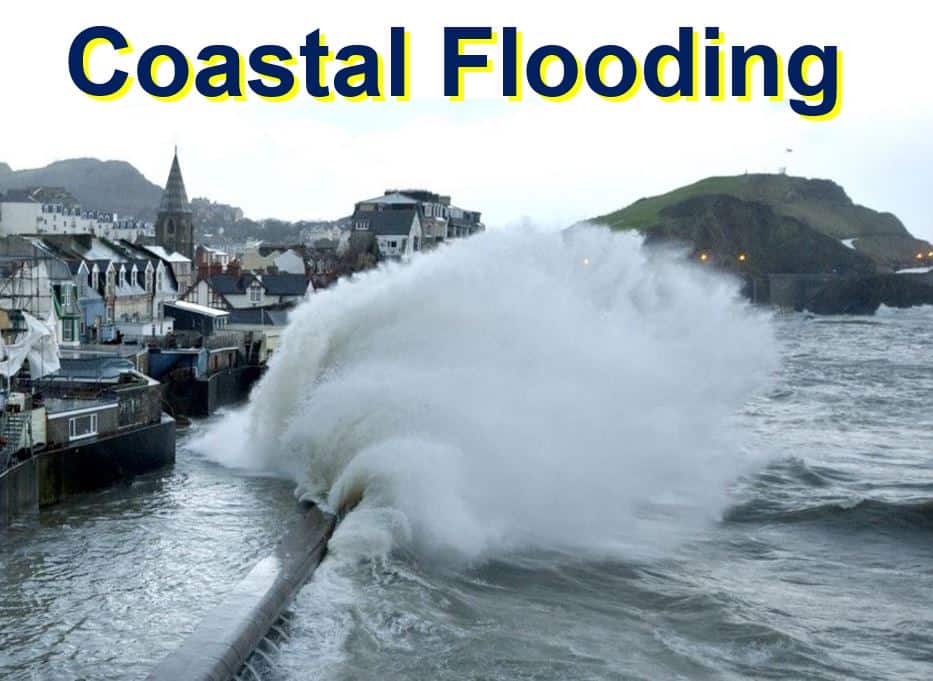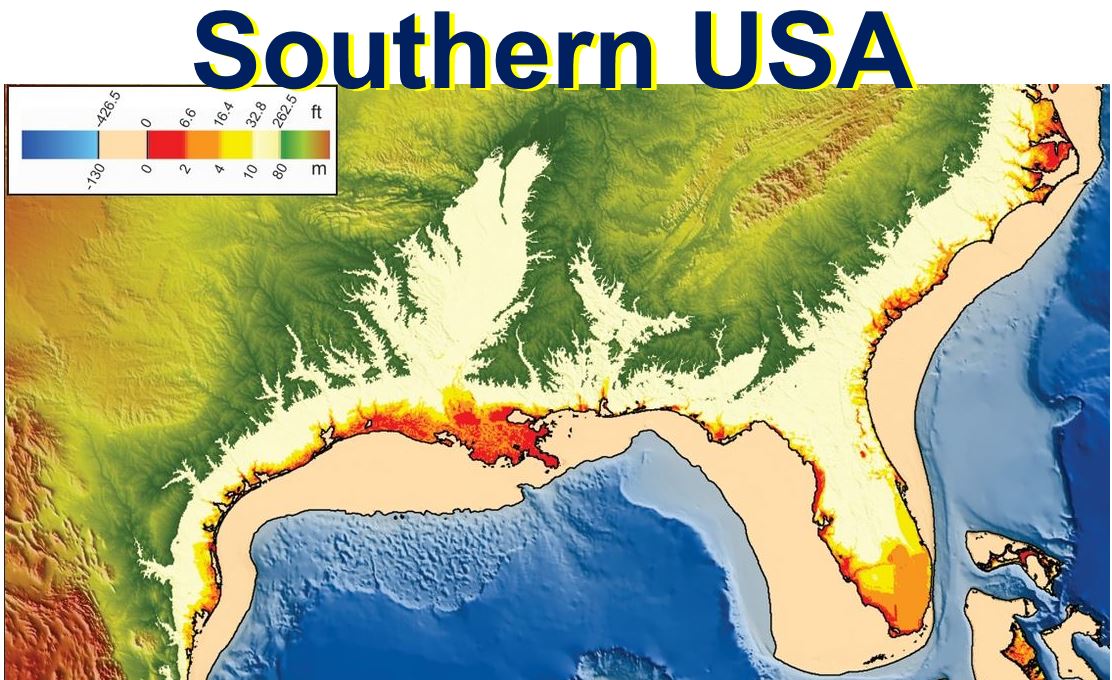The global sea level is rising at breakneck speed, it broke a 2800 year record in the 20th century, says an international team of scientists who were shocked at their findings. In fact, had it not been for global warming, sea levels might even have declined over the past 100 years.
During the 20th century, our seas rose by 5.5 inches (14 centimetres), which is a considerable increase, especially for vulnerable coastal areas at close to sea level. Our seas are expected to rise at an even faster rate this century if we continue relying so heavily on fossil fuels.
Scientists from the USA, UK and Germany wrote about this latest study and their findings in the peer-reviewed journal Proceedings of the National Academy of Sciences (citation below).
 Half of all coastal flooding episodes since 1950 would probably not have occurred without the global warming of the 20th century. (Image: floodsax.co.uk)
Half of all coastal flooding episodes since 1950 would probably not have occurred without the global warming of the 20th century. (Image: floodsax.co.uk)
Sea level rise rate accelerating
Lead author, Robert Kopp, an associate professor in the Department of Earth and Planetary Sciences at Rutgers, the State University of New Jersey, said:
“The 20th-century rise was extraordinary in the context of the last three millennia – and the rise over the last two decades has been even faster.”
Prof. Kopp, together with Jerry Mitrovica, a professor at Harvard University, Carling Hay and Eric Morrow, postdoctoral associates at Rutgers, developed a new statistical approach.
Prof. Kopp said:
“No local record measures global sea level. Each measures sea level at a particular location, where it is buffeted by a variety of processes that cause it to differ from the global mean.”
“The statistical challenge is to pull out the global signal. That’s what our statistical approach allows us to do.”
 The Geological Society of America says our seas are rising ahead of predictions. The map of the USA could look very different in future, with much of Florida disappearing under the sea. (Image: geosociety.org)
The Geological Society of America says our seas are rising ahead of predictions. The map of the USA could look very different in future, with much of Florida disappearing under the sea. (Image: geosociety.org)
Small temperature changes affect sea levels
Earth’s sea levels went down by about 3 inches (8 centimetres) from 1000 to 1400 AD, a period when global temperatures fell by about 0.2°C (0.4°F).
The scientists say it is striking that sea-level changes are related to such a small change in global temperature. Compared to the late 19th century, average global temperatures are about 1°C (1.8°F) higher today. If a 0.2°C change increased the global sea level by 3 inches, imagine what a 1°C change will do.
A statistical analysis is only good if the data it is built on is also good. For this study, a team led by Professor Benjamin Horton, from Rutgers’ department of Marine and Coastal Services, and assistant Professor Andrew Kemp, from Tufts University, compiled a new database of geological sea-level indicators from coral atolls, marshes and archaeological sites spanning a period of 3,000 years.
The database contained records from twenty-four different locations across the world. Many of the records came from the field work of Horton, Kemp, team members Jeffrey Donnelly of the Woods Hole Oceanographic Institution, and Roland Gehrels, of the University of York in the United Kingdom. The analysis also contained data from 66 tide-gauge records from the last 300 years.
Prof. Horton said:
“Scenarios of future rise depend upon our understanding of the response of sea level to climate changes. Accurate estimates of sea-level variability during the past 3,000 years provide a context for such projections.”
 Will London look like this one day? A team of scientists reported earlier this month that the sea level and temperature rises caused by climate change will be here for several thousand years, regardless of what we try to do reduce greenhouse gas emissions. (Image: london-futures.com)
Will London look like this one day? A team of scientists reported earlier this month that the sea level and temperature rises caused by climate change will be here for several thousand years, regardless of what we try to do reduce greenhouse gas emissions. (Image: london-futures.com)
Sea level reconstruction today extremely detailed
Prof. Kemp said:
“As geologists, we can reconstruct how sea level changed at a particular site, and progress in the last 10 years has allowed us to do so with ever more detail and resolution.”
“Gathering together and standardizing these reconstructions gave us a chance to look at what they had in common and where they differed, both of which can tell us about the causes of past, present and future sea-level change.”
Co-authors, Stefan Rahmstorf and Klaus Bittermann, who work at the Potsdam Institute for Climate Impact Research in Germany, calculated how temperatures are linked to the rate of sea-level change by using the study’s global sea-level reconstruction.
Without global warming sea-level might have declined
Based on this temperature-sea level relationship, the scientists found that without global warming, the global sea level in the 20th century would have changed between a decrease of 1.2 inches (3 centimetres) and a rise of 2.8 inches (7 centimetres).
A companion report found that without the climate change-induced component of sea-level rise, over half of the 8,000 coastal nuisance floods detected at studied US tide gauge sites since 1950 would have been avoided.
The researchers also found that the global sea level will most likely rise by 1.7 to 4.3 feet (0.51 to 1.31 metres) during this century if we continue relying so heavily on fossil fuels. If we phase out fossil fuels early enough, we could reduce the rise to between 0.8 and 2 feet (0.24 to 0.6 metres).
In an Abstract in the journal, the authors wrote:
“The 20th century rise was extremely likely faster than during any of the 27 previous centuries. Semiempirical modeling indicates that, without global warming, GSL in the 20th century very likely would have risen by between −3 cm and +7 cm, rather than the ∼14 cm observed.”
 In a report published this month, the authors predict that by 2116 many of us will be living in underwater towns with large skyscrapers. (Image: samsung.com/uk/pdf/smartthings)
In a report published this month, the authors predict that by 2116 many of us will be living in underwater towns with large skyscrapers. (Image: samsung.com/uk/pdf/smartthings)
Underwater cities may be common by 2116
A report, commissioned by Samsung-owned company – SmartThings – predicted that architects, civil engineers and town planners will soon start looking at how we could build cities under the sea.
The underwater cities would have enormous skyscrapers and 3D printed houses. People would have their own personal flying drones instead of cars. These drones would be able to transport your home to, for example, your holiday destination.
The authors of the SmartThings Future Living Report say that if global sea levels are going to continue rising, humans will have less dry land to live on. If we cannot beat this consequence of global warming, we will have no choice.
Seventy-one percent of our planet’s surface consists of water. If that percentage is going to increase, perhaps we should consider living under the sea.
Citation: “Temperature-driven global sea-level variability in the Common Era,” Robert E. Koppa, Andrew C. Kemp, Klaus Bittermann, Benjamin P. Horton, Jeffrey P. Donnelly, W. Roland Gehrels, Carling C. Hay, Jerry X. Mitrovica, Eric D. Morrow, and Stefan Rahmstorf. Proceedings of the National Academy of Sciences (PNAS). 22 February 2016. DOI: 10.1073/pnas.1517056113.
Video – 10 countries most threatened by sea level rise
If sea levels rise by 6 metres in the not-too-distant future, which this video says is highly likely as the ice in Greenland and Antarctica melts, ten countries will be particularly badly affected. The Netherlands – with 60% of its population living within the 6-metre sea-level zone – would suffer the most, experts say. Soon, Egypt’s ancient port city of Alexandria will disappear into the Mediterranean.

